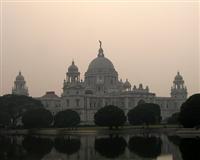 Calcutta OverviewKolkata (formerly Calcutta) is a city of contrasts and
contradictions, and one which has a lasting impact on its visitors.
It is India's third-largest city, and home to some of its holiest
temples and finest colonial structures. As the 'Cultural Capital of India', Kolkata has the biggest
concentration of artists, writers and publishers in the country.
And although it is the centre of Bengali culture, Kolkata is also a
diverse city, with a polyglot mixture of languages spoken amongst
its 14 million inhabitants. Kolkata was home to two Nobel Laureates - Mother Theresa, whose
humble home can still be visited - and writer Rabindranath Tagore.
The city also accommodates sports fans, with Eden Gardens, the
city's temple to cricket and the second-largest cricket stadium in
the world; and Saltlake Stadium, one of the world's largest
football venues, with an unbelievable capacity of 120,000. From 1772 to 1912 Kolkata was the capital of the British Raj - a
legacy evident in its superb colonial architecture (highlighted by
the enormous Victoria Memorial), and well-planned infrastructure.
The latter half of the 20th century, however, saw Kolkata enter a
period of decline, with rampant poverty and economic stagnation. It
was only in the 1980s, under India's first democratically-elected
Marxist administration, that the city turned the corner. Today, visitors making the journey to this eastern corner of the
country will find a city that has rediscovered its pride and
cultural identity, offering a Bengali welcome warm enough to seduce
even the most jaded traveller. |